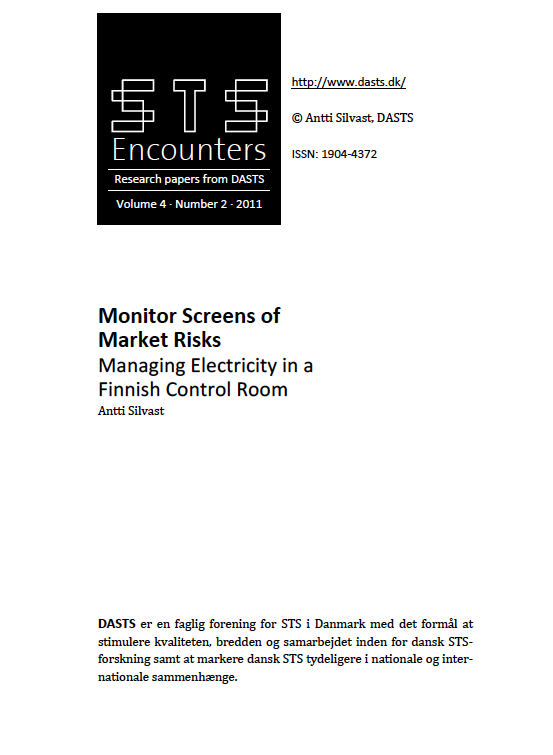Monitor Screens of Market Risks
Managing Electricity in a Finnish Control Room
DOI:
https://doi.org/10.7146/stse.v4i2.135126Abstract
Electricity control rooms are the subject of many recent organizational studies. These studies have brought together the topics of technological risks and reliability with ethnographic methodologies and the broader themes in public policy and management. With a few exceptions, however, the technological artifacts of electricity control room work have received little systematic attention. This article tries to address this gap by discussing a technology that is pervasive in control room settings: the computer monitor. The research question asks what the effects of these devices are in electricity control room settings and especially in relation to the management of market risks in electricity supply. The article draws upon ethnographic research of an electricity control room in Finland. Motivated by sociological research on market devices, attention is paid to the ‘screened’ relationships between control room practices and the Nordic market of electrical energy. The analysis illustrates how market place bidding on monitors can discipline control room work and extend the capabilities that the control room workers have for calculating uncertainties and risk. However, while the screened market place on the monitors enacts a comprehensive global “economic world”, the analysis also shows how the screened market prices and energy quantities are always shaped by local work practices. One example of this concerns the weather. The local weather impacts energy generation and consumption levels directly. Hence while calculating energy market bids the control room workers need to ‘screen’ upcoming weather and stay alert to weather fluctuations. Emphasis on local practice is also relevant as it highlights a salient aspect of control room monitors: the monitors’ relation with working habits. Monitors, interacted with continuously in the control room, can become part of a working habit and appear to be mastered without that much constant reflection. The article concludes by relating its findings to debates on risks and markets. It claims that ethnographic knowledge from sites such as energy market control rooms adds to the understanding of market risks as it introduces a relevant and original aspect: management of uncertainties that works through real-time engagement with technological artifacts. In the case of the control room practice, market risks are not so much managed or ‘perceived’ by controllers alone. Rather they are dealt with through an assemblage of people, habits, numbers and monitors continuously working together to produce a reliable infrastructure service in ever-changing situations.

Downloads
Published
How to Cite
Issue
Section
License

This work is licensed under a Creative Commons Attribution-NonCommercial-ShareAlike 4.0 International License.
Starting with volume 15, articles published in STS Encounters are licensed under Attribution-NonCommercial-ShareAlike 4.0 International (CC BY-NC-SA 4.0). The editorial board may accept other Creative Commons licenses for individual articles, if required by funding bodies e.g. the European Research Council. Previous articles are not licensed under Creative Commons. In these volumes, all rights are reserved to the authors of the articles respectively.




